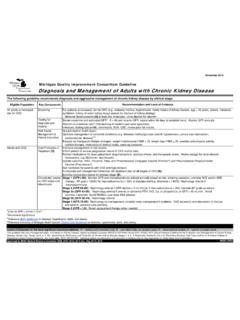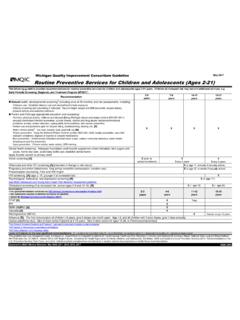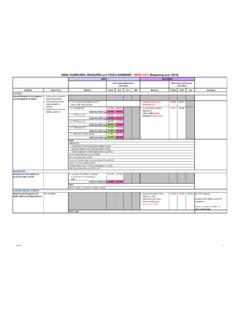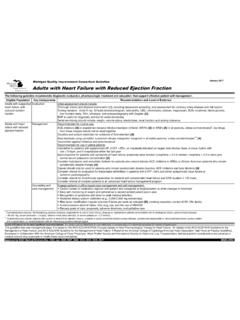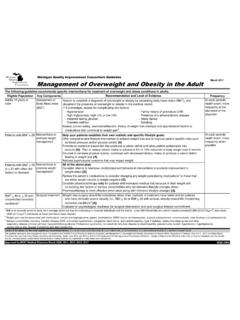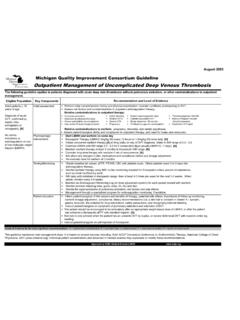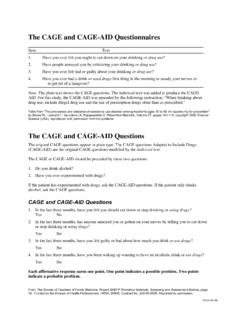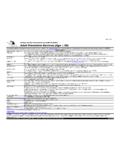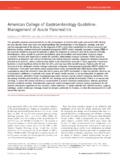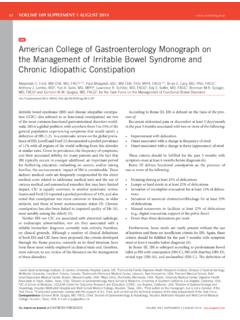Transcription of American College of Rheumatology 2012 …
1 Arthritis Care & Research Vol. 64, No. 4, April 2012 , pp 465 474. DOI 2012 , American College of Rheumatology SPECIAL ARTICLE. American College of Rheumatology 2012 . recommendations for the Use of Nonpharmacologic and Pharmacologic Therapies in Osteoarthritis of the Hand, Hip, and Knee MARC C. HOCHBERG,1 ROY D. ALTMAN,2 KARINE TOUPIN APRIL,3 MARIA BENKHALTI,3. GORDON GUYATT,4 JESSIE MCGOWAN,3 TANVEER TOWHEED,5 VIVIAN WELCH,3. GEORGE WELLS,3 AND PETER TUGWELL3. Guidelines and recommendations developed and/or endorsed by the American College of Rheumatology (ACR) are intended to provide guidance for particular patterns of practice and not to dictate the care of a particular patient. The ACR considers adherence to these guidelines and recommenda- tions to be voluntary, with the ultimate determination regarding their application to be made by the physician in light of each patient's individual cir- cumstances. Guidelines and recommendations are intended to promote beneficial or desirable outcomes but cannot guarantee any specific outcome.
2 Guidelines and recommendations developed or endorsed by the ACR are subject to periodic revision as warranted by the evolution of medical knowl- edge, technology, and practice. The American College of Rheumatology is an independent, professional, medical and scientific society which does not guarantee, warrant, or endorse any commercial product or service. Objective. To update the American College of Rheumatology (ACR) 2000 recommendations for hip and knee osteoarthritis (OA). and develop new recommendations for hand OA. Methods. A list of pharmacologic and nonpharmacologic modalities commonly used to manage knee, hip, and hand OA as well as clinical scenarios representing patients with symptomatic hand, hip, and knee OA were generated. Systematic evidence-based literature reviews were conducted by a working group at the Institute of Population Health, University of Ottawa, and updated by ACR staff to include additions to bibliographic databases through December 31, 2010.
3 The Grading of recommendations Assessment, Development and Evaluation approach, a formal process to rate scientific evidence and to develop recommendations that are as evidence based as possible, was used by a Technical Expert Panel comprised of various stakeholders to formulate the recommendations for the use of nonpharmacologic and pharmacologic modalities for OA of the hand, hip, and knee. Results. Both strong and conditional recommendations were made for OA management. Modalities conditionally recom- mended for the management of hand OA include instruction in joint protection techniques, provision of assistive devices, use of thermal modalities and trapeziometacarpal joint splints, and use of oral and topical nonsteroidal antiinflammatory drugs (NSAIDs), tramadol, and topical capsaicin. Nonpharmacologic modalities strongly recommended for the management of knee OA were aerobic, aquatic, and/or resistance exercises as well as weight loss for overweight patients.
4 Nonpharmacologic modalities conditionally recommended for knee OA included medial wedge insoles for valgus knee OA, subtalar strapped lateral insoles for varus knee OA, medially directed patellar taping, manual therapy, walking aids, thermal agents, tai chi, self- management programs, and psychosocial interventions. Pharmacologic modalities conditionally recommended for the initial management of patients with knee OA included acetaminophen, oral and topical NSAIDs, tramadol, and intraarticular corticosteroid injections; intraarticular hyaluronate injections, duloxetine, and opioids were conditionally recommended in patients who had an inadequate response to initial therapy. Opioid analgesics were strongly recommended in patients who were either not willing to undergo or had contraindications for total joint arthroplasty after having failed medical therapy. Recom- mendations for hip OA were similar to those for the management of knee OA.
5 Conclusion. These recommendations are based on the consensus judgment of clinical experts from a wide range of disciplines, informed by available evidence, balancing the benefits and harms of both nonpharmacologic and pharmacologic modalities, and incorporating their preferences and values. It is hoped that these recommendations will be utilized by health care providers involved in the management of patients with OA. INTRODUCTION and pharmacologic modalities (1). The American College Many patients with a clinical diagnosis of osteoarthritis of Rheumatology (ACR) last published recommendations (OA) are treated with a combination of nonpharmacologic for the management of hip and knee OA in 2000 (2), with 1. Marc C. Hochberg, MD, MPH: University of Maryland Peter Tugwell, MD, MSc:University of Ottawa School of School of Medicine, Baltimore; 2 Roy D. Altman, MD: David Medicine, Ottawa, Ontario, Canada; 4 Gordon Guyatt, MD: Geffen School of Medicine, University of California, Los An- McMaster University School of Medicine, Hamilton, On- geles; 3 Karine Toupin April, OT, PhD, Maria Benkhalti, MSc, tario, Canada; 5 Tanveer Towheed, MD, MSc: Queen's Uni- Jessie McGowan, PhD, Vivian Welch, MSc, George Wells, MD, versity School of Medicine, Kingston, Ontario, Canada.
6 465. 466 Hochberg et al an addendum posted on the ACR web site in February mation on the safety and tolerability of existing therapies 2005 (3). Since 2000, other professional societies have for OA have become available and, as noted above, the published recommendations for the management of hand, methodology for developing clinical practice guidelines hip, and knee OA, including those developed by the Eu- has evolved. These factors combined to contribute to the ropean League Against Rheumatism (EULAR) (4 6), the decision of the ACR to revise and update recommenda- Osteoarthritis Research Society International (OARSI) (7), tions for the management of OA of the hip and knee as well and the American Academy of Orthopaedic Surgeons as create new recommendations for the management of OA. (AAOS) (8). of the hand. Applying these recommendations in clinical Past ACR recommendations for the management of hip practice requires individualized assessment of the patient and knee OA were derived by a small group using an and consideration of the values and judgments of both the informal consensus approach following an extensive liter- practitioner and the patient.
7 The recommendations pro- ature review. Since then, the methodology used to develop vided here are not intended to be used in a cookbook . clinical practice guidelines has matured with the use of fashion, but rather to provide guidance based on clinical systematic literature reviews and the implementation of evidence and expert panel input. Unlike previous ACR. the Delphi method for development of consensus agree- recommendations for the management of OA, these recom- ment on propositions (4 7) or the RAND/University of mendations do not recommend the sequence of subse- California, Los Angeles Appropriateness Method for deter- quent interventions for those failing to have an adequate mining when the use of certain therapeutic modalities is response to recommended initial therapies, as there are appropriate in a given clinical scenario (9). The current few, if any, high-quality studies that were designed to recommendations were developed using the Grades of examine the benefit and safety of specific modalities under Recommendation Assessment, Development and Evalua- such assumptions.
8 Although disseminated under the aegis tion (GRADE) approach, a formal process to develop rec- of the ACR, we hope that these recommendations will ommendations that are as evidence based as possible. The have relevance to practitioners throughout the world. We GRADE approach has been adopted by the World Health specifically did not make recommendations regarding the Organization, the Cochrane Collaboration, the Agency for use of pharmacologic agents that are not approved in the Healthcare Research and Quality (AHRQ) (10 14), and US and Canada, however, or regarding the use of surgical numerous professional organizations including, among interventions, as this was beyond the scope of the charge others, the American College of Physicians and, most re- to the committee. cently, the ACR. Since 2000, new therapies for OA and additional infor- MATERIALS AND METHODS. Dr. Hochberg has received consultant fees (less than Initial systematic literature review.)
9 Systematic litera- $10,000 each) from Abbott Laboratories, Amgen, AstraZeneca, Bayer Health Care, Bioiberica, Bristol-Myers Squibb, Com- ture searches were conducted by a working group at the binatoRx, Covidien, Eli Lilly, Genentech, GlaxoSmithKline, University of Ottawa, which also organized the summary Hoffman-La Roche, Merck, Merck Serono International, evidence profiles and supporting documents. Systematic NicOx, Novartis, Pfizer, Pozen, Rand Corporation, Sanofi- literature searches were performed for more than 50 dif- Aventis, Smith & Nephew, Stryker Biotech, TransPharma ferent nonpharmacologic and pharmacologic modalities Medical, and UCB, receives research support from the NIH, serves as a member/chair of the data safety monitoring that were previously identified by separate expert panels boards for the National Eye Institute and Novartis, and (4 7); note that tramadol was considered separately from serves on the medical advisory board for and owns stock in opioid analgesics because the central analgesic effect of Theralogix.
10 Dr. Altman has received consultant fees, speak- tramadol is thought to be mediated not only by a weak ing fees, and/or honoraria (less than $10,000 each) from Ferring, Rotta, Endo, Novartis, Lilly, and Smith & Nephew. opioid receptor agonist effect but also through modula- Dr. Towheed has received speaking fees from and/or serves tion of serotonin and norepinephrine levels. Literature on the advisory board for Amgen, Novartis, Bristol-Myers searches were not performed for medications that are not Squibb, Hoffman-La Roche, and Schering (less than $10,000 commercially available in the US and Canada. The initial each). Dr. Tugwell has received consultant fees (more than searches were conducted in Medline (1950 2009), Embase $10,000 each) from Abbott, Almirall, AstraZeneca, Aventis, Berlex, Biomatrix, Bristol-Myers Squibb, Caduceus Group, (1980 2009), and The Cochrane Library (issue 3, 2009) by Centocor, Chelsea, Dimedix, Dimethaid, Eli Lilly, Glaxo- applying database subject headings and relevant keywords Welcome, GlaxoSmithKline, Hoechst Marion Roussel, Im- (see Supplementary Appendix A for the search strategy munomedics, Innovus, Johnson & Johnson, Larvol, Lilly Re- employed for exercise, available in the online version of search, Medicine Group, Medicus, Merck, Merck Frosst, Novartis, Novopharm, Ortho McNeil, Pennside, Pfizer, this article at Roche, Sandoz, Scios, Searle, Teva Pharmaceuticals, UCB, (ISSN)2151-4658).
